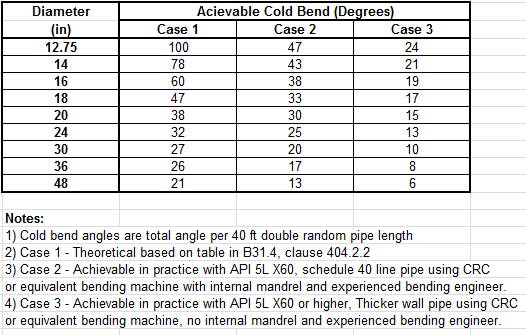My response above is an answer to your original question in relation to cold bending of line pipe in reference to design codes (i.e. what is the minimum allowable cold bend angle per code?). Please note that the bend angles stated in my first reply are also applicable to your B31.8 pipeline design. As I re-read and further more carefully assessed the responses,it is concluded that your question is not that, but is something quite different. But firstly a few comments regarding information in the the other responses and your replies to these. You state that the line pipe is 24-inch diameter and the cold bend radius may be 260 meters. LittleInch is correct in that this is equivalent to a 430D bend radius.... but further, this is equivalent to a 2.7 degree total bend angle in a 12 meter long pipe joint. This is a relatively small cold bend angle for this length of 24" pipe joint as this diameter pipe welded together and laid in the trench should be able to elastically flex to reasonably conform to this trench bottom grade transition without the pipe becoming over stressed during operating conditions, unless if it is very heavy wall thickness and/or there is no elastic bending reserve in the wall thickness design.
By piecing together the various comments and responses it is suspected your real question is something like, "... given the that the there are 430D cold bends in the pipe segments, will they be over stressed during the contractors' lowering-in operation or afterwards during operational phase?". If the contractor has mobilized sufficient side boom tractors to properly support the pipe string during the lowering-in operation, and the lowering in crew/operators are sufficiently experienced then any concerns with over stressing the cold bent segments will be mitigated. Also, to answer your question, "...is it correct to assume that the maximum bending stress is the same as for a straight pipe section?", the answer is "yes" for all practical purposes (considering minor effects of bend thinning of the cold bent segments). In fact it is believed that the localized cold bent locations have been strain hardened due to the cold bending process. In addition please note that during installation, the pipeline is unpressurized and therefore can accommodate signficantly greater bending stress without yielding than for the pressurized condition for which the pipe wall thickness was designed.
As a side note, please be advised that pipeline construction contractors do in many instances "cut corners" in their bids and during construction...especially the low bidders. During detail design phase, the construction aspects should have been addressed, including the size and number of sideboom tractors required for the lowering in operation so as to prevent pipeline overstressing concerns. This is presented in a "Method Statement" that should include a drawing of the lowering-In operation with sidboom tractor capacities. Alternatively, if this was not provided during the detail design phase, the Client should require the contractor to provide such Method Statement to be submitted to them for their review and approval prior to the contractor performing any lowering-in operations for the project during the construction phase. This type of analysis generally requires the use of pipe stress analysis software (such as CAESAR II) to properly model the lowering-in operation. From this modeling, the loads on each of the sideboom tractor lift points can be identified, and then the appropriate side boom equipment capacity (with safety factor)to do the job can be identified using vendor equipment data sheets obtained on the internet.....the contractor will need to validate that he has mobilzed this capacity sideboom tractors or equivalent for the job.

